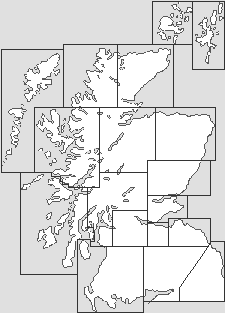 Houbie from the South-East, with Leagarth House in the Foreground |
Fetlar is the fourth largest of the Shetland Islands, with an irregular shape that measures a maximum of six miles by five and covers some 15 square miles. It is sparsely populated, with just 61 residents in 2011, down from 86 a decade earlier. It is reached from Mainland Shetland by crossing via the Yell Sound Ferry to Yell, then crossing Yell to catch the triangular Bluemull Sound Ferry that links Yell, Unst and Fetlar. Booking ahead is recommended as only a few services each day call at Fetlar. And if bringing a car to Fetlar (and one is recommended if you hope to see the whole of the island) it pays to remember that there is no fuel on sale here.
The name comes from the Old Norse for prosperous or fat land: and reflects Fetlar's good quality agricultural land. This is also why the island is often called "the garden of Shetland". An unexpected result is that Fetlar can feel much more like a northern Orkney Islands such as Westray rather than its peat-covered neighbours of Yell and Unst.
If Fetlar itself is very irregular in shape, its road network is surprisingly symmetrical. A single road runs north-west to south-east for the length of the island. At both ends there is a spur leading to the north, while in the centre there is an angular loop reaching the south coast at Tresta.
Tresta is home to one of Fetlar's finest beaches, behind which is Fetlar Kirk. Nearby is the island's campsite, complete with fairly basic facilities.
Fetlar's main settlement is Houbie, situated where the main road across the island touches the south coast. The term "main settlement" is a relative one: most of it can be seen in the header image. Houbie has a concrete pier reaching out out into the Wick of Tresta. Opposite its landward end is a must-see on Fetlar, the Fetlar Interpretive Centre. Houbie is also home to Fetlar's shop and post office. Overlooking it from the east is Leagarth House, which in the early 1900s was the retirement home of the eminent surgeon Sir William Watson Cheyne.
A little to the east of Houbie is Fetlar's Community Hall, on a superb location overlooking the Wick of Tresta. To its east is Aith Ness. Here are the modern buildings of the Convent of The Society of Our Lady of the Isles (SOLI). And nearby, easily overlooked, is a remarkable gem, the Byre Chapel. Originally created to serve the nearby convent, it has a wonderful atmosphere that brings to mind very clearly the story of the nativity.
In the middle of Fetlar a track leads north from the main road to the island's small airstrip, perched on moorland at a height of 250ft. At the island's east end is Brough Lodge, the strange rambling home of the island's owners, the Nicolson family, until the latter 1900s, when it was left empty. A trust has been set up to preserve and restore the lodge for the benefit of islanders and visitors.
North of Brough Lodge the road leads to Fetlar's new ferry terminal at Hamars Ness, just around the point from the old ferry terminal at Oddsta. Not far away is a relic of an even older ferry service. At the end of the east west road near Brough Lodge you can still see the old pier with a heavily rusted winding gear nearby.
And roped to the winding gear are the sad remains of Fetlar's flit boat, which until the 1970s was rowed ashore from the Lerwick steamer carrying all the islands passengers, supplies and freight. A photo even exists of the flit boat coming ashore with a 1920s motor car balanced crossways aboard it on two planks!
Fetlar has a very ancient history and relics from Neolithic and Bronze Ages can be seen here. Most remarkable are the remains of the Finnigert Dyke, which cut the island in half from north to south like some Bronze Age Berlin Wall. And it is entirely possible that the Dyke had a similar purpose, to separate two competing or even warring tribes.
The Dyke was still complete when the Vikings arrived and took control of Fetlar. Indeed, because of the wall, the Vikings seemed to treat Fetlar as two entirely separate islands, Est Isle and Wast Isle. The Vikings never left, being the direct ancestors of today's Shetlanders. Fetlar's Viking legacy was explored by a "Time Team" archaeological dig in August 2002 which produced some remarkable finds on view in the Fetlar Interpretive Centre.
In 1841 the population of this prosperous island stood at 761. It was probably already past its high point by then, because in 1822 the island's owner Sir Arthur Nicholson started to clear tenants from the south-west of Fetlar to make room for sheep. By 1858 he had cleared 30 townships across large parts of the island and by 1891 the population had shrunk to 363. It has steadily declined ever since, to 2001's 86.
 Funzie Bay - The East End of Fetlar |

|
|
|
Visitor InformationView Location on Map |
 Fetlar Interpretive Centre |
 Fetlar Community Hall |
 Fetlar Church |
 Society of Our Lady of the Isles |





